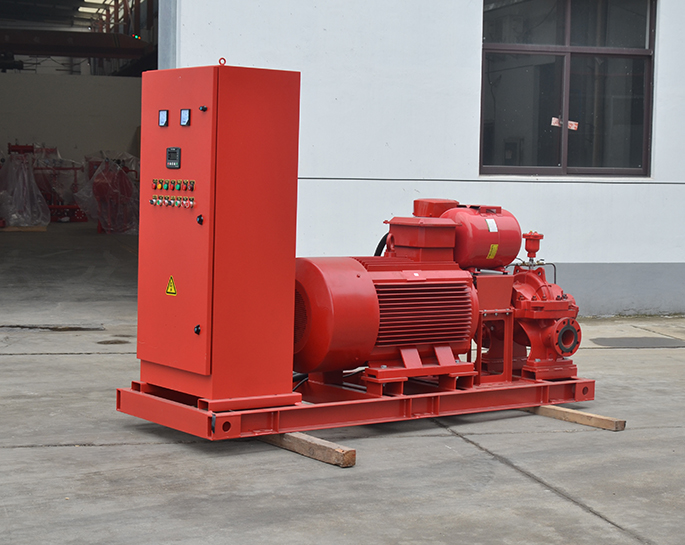Are there any specific requirements for the installation of electric fire pumps in hazardous or classified environments?
Apr 01, 2024
Share:
Yes, the installation of electric fire pumps in hazardous or classified environments must adhere to specific requirements to ensure safety and compliance with applicable regulations. Here are some key considerations:
1. **Hazardous Area Classification**: Identify and classify the hazardous areas within the facility where the fire pump will be installed. Hazardous areas are typically classified based on the presence of flammable gases, vapors, liquids, or combustible dusts. Common classification systems include those defined by organizations such as the National Electrical Code (NEC) in the United States or the International Electrotechnical Commission (IEC).
2. **Motor and Equipment Selection**: Choose motors, electrical components, and accessories that are suitable for use in hazardous locations. These components must be designed and certified for the specific hazardous area classification where they will be installed. Look for motors with appropriate explosion-proof or flameproof enclosures, as well as other necessary certifications such as ATEX (EU directive) or CSA/UL HazLoc (North America).
3. **Wiring and Conduit**: Use appropriate wiring methods and conduit systems that provide protection against the risks of fire and explosion in hazardous areas. Install conduits and cable glands rated for hazardous locations, and ensure proper sealing and bonding to prevent the entry of flammable gases or dusts.
4. **Grounding and Bonding**: Implement effective grounding and bonding measures to minimize the risk of static electricity buildup and electrostatic discharges in hazardous environments. Proper grounding ensures that any fault currents are safely diverted away from sensitive equipment and personnel.
5. **Ventilation and Venting**: Provide adequate ventilation to prevent the accumulation of flammable gases or vapors in enclosed spaces where fire pumps are installed. Ventilation systems should be designed to maintain safe levels of oxygen and to remove any potentially hazardous substances from the area.
6. **Emergency Shutdown Systems**: Install emergency shutdown systems that can quickly isolate power to the fire pump and associated equipment in the event of a fire or other hazardous situation. These systems should be designed to operate safely in hazardous environments and to minimize the risk of ignition sources.
7. **Compliance with Regulations**: Ensure that the installation of electric fire pumps in hazardous areas complies with all relevant regulations, codes, and standards applicable to the specific industry and geographical location. This may include regulations such as NEC Article 500-505 (in the U.S.), IEC 60079 series (internationally), or other local regulatory requirements.
8. **Training and Awareness**: Provide training and awareness programs for personnel involved in the installation, operation, and maintenance of electric fire pumps in hazardous locations. Ensure that personnel are familiar with the risks associated with working in hazardous environments and are trained to follow proper safety procedures at all times.
By addressing these considerations and following best practices for the installation of electric fire pumps in hazardous environments, you can help mitigate risks and ensure the safety and reliability of fire protection systems in industrial facilities and other high-risk settings.

1. **Hazardous Area Classification**: Identify and classify the hazardous areas within the facility where the fire pump will be installed. Hazardous areas are typically classified based on the presence of flammable gases, vapors, liquids, or combustible dusts. Common classification systems include those defined by organizations such as the National Electrical Code (NEC) in the United States or the International Electrotechnical Commission (IEC).
2. **Motor and Equipment Selection**: Choose motors, electrical components, and accessories that are suitable for use in hazardous locations. These components must be designed and certified for the specific hazardous area classification where they will be installed. Look for motors with appropriate explosion-proof or flameproof enclosures, as well as other necessary certifications such as ATEX (EU directive) or CSA/UL HazLoc (North America).
3. **Wiring and Conduit**: Use appropriate wiring methods and conduit systems that provide protection against the risks of fire and explosion in hazardous areas. Install conduits and cable glands rated for hazardous locations, and ensure proper sealing and bonding to prevent the entry of flammable gases or dusts.
4. **Grounding and Bonding**: Implement effective grounding and bonding measures to minimize the risk of static electricity buildup and electrostatic discharges in hazardous environments. Proper grounding ensures that any fault currents are safely diverted away from sensitive equipment and personnel.
5. **Ventilation and Venting**: Provide adequate ventilation to prevent the accumulation of flammable gases or vapors in enclosed spaces where fire pumps are installed. Ventilation systems should be designed to maintain safe levels of oxygen and to remove any potentially hazardous substances from the area.
6. **Emergency Shutdown Systems**: Install emergency shutdown systems that can quickly isolate power to the fire pump and associated equipment in the event of a fire or other hazardous situation. These systems should be designed to operate safely in hazardous environments and to minimize the risk of ignition sources.
7. **Compliance with Regulations**: Ensure that the installation of electric fire pumps in hazardous areas complies with all relevant regulations, codes, and standards applicable to the specific industry and geographical location. This may include regulations such as NEC Article 500-505 (in the U.S.), IEC 60079 series (internationally), or other local regulatory requirements.
8. **Training and Awareness**: Provide training and awareness programs for personnel involved in the installation, operation, and maintenance of electric fire pumps in hazardous locations. Ensure that personnel are familiar with the risks associated with working in hazardous environments and are trained to follow proper safety procedures at all times.
By addressing these considerations and following best practices for the installation of electric fire pumps in hazardous environments, you can help mitigate risks and ensure the safety and reliability of fire protection systems in industrial facilities and other high-risk settings.


.png)
.png)

.png)


